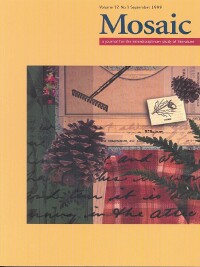Issue 32.3
Overview

General Issue
Published: September 1999
View the issue introduction or see the issue summary and contents below.
8 essays, totalling 170 pages
$15.00 CAD
True to its interdisciplinary mandate, this general issue of Mosaic contains essays that seek new approaches to the study of literature and film, or that examine literature that has been created around the principles of other disciplines. Essays examine the mathematic approach of the OuLiPo, the influence of jazz in Michael Ondaatje’s work, and other critical work influenced by gender studies, cultural studies, and scientific studies. Among these is a notable emphasis on the relationship between sight and language.
Elizabethan Appropriation of Irish Culture: Spenser’s Theory vs. Lee’s PracticeDon-John Dugas Focusing on differences between the careers and writings of Edmund Spenser and Captain Thomas Lee, this essay argues that whereas Spenser viewed any English appropriation of Irish culture as “degenerate,” Lee adopted a hybrid Anglo-Irish identity that ultimately enhanced his effectiveness as a colonial officer. | |
Disciplinary Hybridity in Shelley’s AdonaisLinda C. Brigham Arguing the impossibility of interdisciplinarity between the humanities and the sciences given current cultural formations, this essay sketches ways of altering these formations, using theories advanced by Bruno Latour and Niklas Luhmann. By way of concrete illustration and experiment, an interdisciplinary reading of a high-cultural work, Shelley’s Adonais is provided. | |
Tennyson’s “The Gardener’s Daughter”: The Exegesis of an IconLawrence J. Starzyk Focusing on questions of possession and resemblance in Victorian aesthetics, this essay analyzes Tennyson’s “The Gardener’s Daughter” as paradigmatic of romanticism’s abandonment of a disjunctive poetics that insisted on the supremacy of either the visual or the verbal, favoring a synergistic approach in which word and image contend inconclusively. | |
Turning Words into Colors: Robbe-Grillet’s Visual LanguageLaurent Déchery Drawing upon a variety of theories about perception, this essay explores the philosophy and techniques which informed Art Nouveau. Specific focus is on Alain Robbe-Grillet’s attempt to make the reader think “visually” in his short story “The Secret Room.” | |
Reverence, Rape, Resistance: Joyce Carol Oates and Feminist Film TheoryMarilyn C. Wesley Feminist film criticism has explored not only the way that representation of women operates as a form of exploitation masked as idolizing but also the ways that the female spectator can subvert the masculine gaze. This essay applies such theorizing to Joyce Carol Oates’s short story “The Girl,” which focuses on the filming of a rape. | |
Writing by Numbers: OuLiPo and the Creativity of ConstraintsColin Symes Current research in cognitive science argues that constraints are conducive to creativity. Supporting such contentions, this essay examines the work of a group of French writers known as OuLiPo. Specific focus is on their use of mathematical structuring principles, of which the work of Georges Perec is the pre-eminent example. | |
Culture as Transition: Becoming a Woman in Bi-ethnic SpaceMaria Szadziuk Viewing culture as a dynamic process which is played out on the individual as well as the social level, this essay examines the autobiographical narratives of three American women of Hispanic descent: Esmeralda Santiago, Sandra Cisneros, and Cherrié Moraga. Focus is on the metaphor of culture-as-travel and on the differing ways that progressive removal from ethnic roots is regarded and expressed. | |
Solos and Chorus: Michael Ondaatje’s Jazz Politics/PoeticsDouglas Malcolm More than serving merely as a metaphor, jazz—its formal rules—can play a structuring role in society and literature. Focusing on In the Skin of a Lion, this essay explores the way that Michael Ondaatje uses the concepts of solo and chorus to improvise and create order at both levels. |